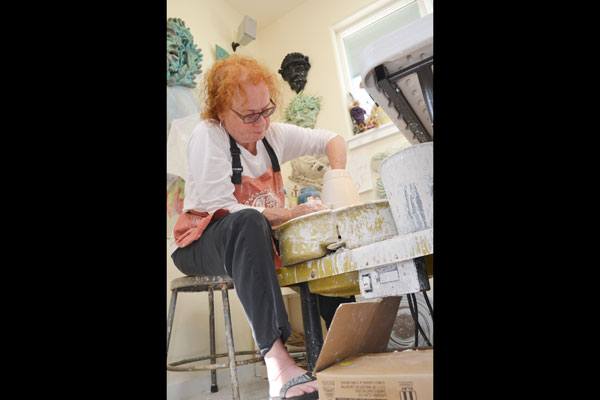For Linda Collins Chapman, when one drawing pad runs out a potter’s wheel spins open.
The master potter wasn’t always on the path to ceramics mastery. If it were’t for one upper-level drawing class filling up at the University of Colorado, Collins Chapman might have become an illustrator rather than the well-respected ceramics artist she is today.
Coming from a family with a music and education background, Collins Chapman grew up with a love for both, which led to college scholarships and studies in art and music.
“But I learned quickly you can’t focus on both music and clay,” she said.
Collins Chapman set course for ceramics full time but it was temporarily delayed a few more years as her husband, Ned, was transferred in the U.S. Navy to California. She took to community college there and earned her fine arts degree back in Colorado five years later. And ever since, she’s been engrossed everyday behind her potter’s wheel as Linda Chapman Design.
“Even the night before I went into labor (with son Colin), I was loading the kiln to fire,” she said.
The basics
She started “basic,” with a wheel, a few shelves and a kiln after college.
But she worked her way and skill level up, traveling to multiple craft fairs, festivals and markets selling her wares, particularly American Craft Council shows, which she said are the gold standard of ceramics shows.
“I work to make my work super elegant,” she said. “If it’s not perfect, it doesn’t go out.”
Those high standards led to her work appearing in galleries from coast to coast.
“I’ve devoted my whole life to the ceramics practice,” she said.
One of the pinnacles of her career, she said, was having her work displayed at the Smithsonian Institute, Renwick Gallery in the 1980s.
Keen eye
The ceramics process is something you must pay attention to all the time, she finds.
“If the humidity changes, the clay might dry out fast,” Collins Chapman said.
“In Sequim, the humidity is fairly dry but you still have to pay attention to it everyday.”
When working with clay, she always works in a series but to a smaller production level using the potter’s wheel, slab roller and molding with her hand.
“Centering (on the wheel) is pivotal, but then again every step is,” she said.
For her clay, she prefers a white, smooth porcelain, dense clay. She most often uses the sgraffito technique when the clay is leather hard and scratching to make a design. The initial firing takes the raw clay and changes it into a ceramic material. After it’s glazed, the ceramics piece is fired at 2,200 degrees.
Collins Chapman said some pieces can be fired multiple times if you aren’t happy with it until you get the effect you desire. To create slips and glazes, Collins Chapman has referred to the same book in her career.
“You want the same results over and over,” she said.
It’s not uncommon for customers from 20 years prior to return with a broken plate asking for the same thing again. “A potter would be out of business if they didn’t break,” she said.
She learned to fire her work in an outdoor kiln that uses gas, but Collins Chapman “bit the bullet,” she said, and learned to use an electric kiln and the chemistry behind it because it’s totally different.
“Few people were using it then but now it’s standard,” she said. “It saves energy and is cleaner and uses consistent oxygen.”
Today she uses a mid-range, fire oxidation kiln with all-porcelain pieces for all functional work. For purists wondering, she made the switch from a kick wheel to electric in the early 1980s.
Her sculptural work is done differently with different clay bodies. While Collins Chapman believes in consistency, she said she’s observed the trends in colors, shapes and techniques through the years, such as brown pottery from the 1970s.
“When doing shows, you paid attention to the colors,” she said. “In the 1980s, people were doing a lot of pastels.”
She finds a timelessness in the black and white pottery, which she grew to love from her grandfather, a painter. He loved loved Lucy Lewis, whom Collins Chapman considers one of the best Pueblo potters.
Ceramics in Sequim
Collins Chapman moved to the area in 2011 after nine years in Kauai, Hawaii. She continued her business there but founds costs too high.
“I was basically giving my work away for free,” she said. “It’s totally different living there but I wouldn’t trade it for anything.”
She’s setup a studio in Sequim where she continues making an array of pots, dishes, masks and more.
Her ceramics are currently found in Kauai and the Port Angeles Fine Arts Center. You can meet her at an upcoming show with the art collective ARTfusion from Oct. 18-19 at the Cutting Garden.
For more information on Linda Collins Chapman, call 797-1753 or visit lindachapmandesign.com.



